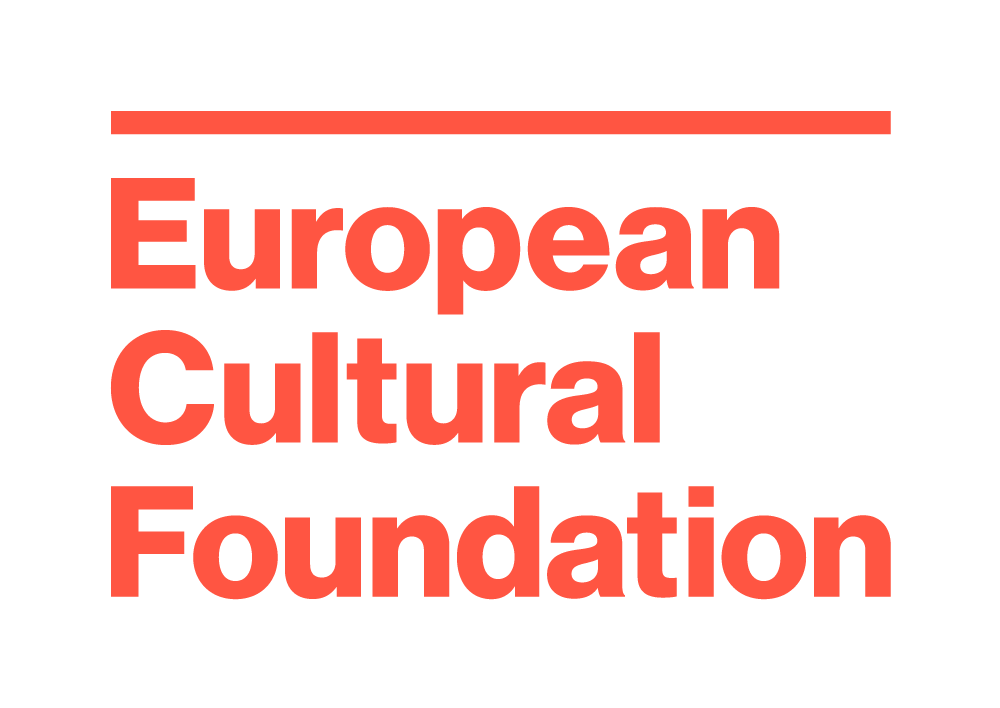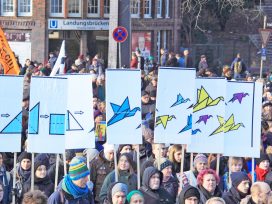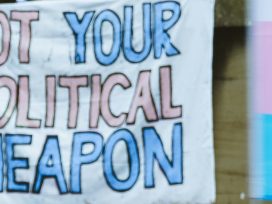Black power after Obama
Following the disappointment of Obama, what is the way forward for the campaign against the criminalization of black people across the United States? Affinities between Black Lives Matter and traditions of community organizing show the potential for new coalitions, argues Julien Talpin.
One Friday morning, about forty people gathered at the headquarters of the Community Coalition (one of the city’s most powerful community organizations) in the south of Los Angeles, to attend an exceptional meeting between two currents of the American black liberation movement: the new guard, represented by the activists of Black Lives Matter, on the one hand, and the activists of the 80-year-old organization the Nation of Islam1 on the other. At issue was the planning for both groups’ participation in a large demonstration scheduled for October 2015 in Washington, to mark the 20th anniversary of the ‘Million Man March’, a high point in the black movement of the 1990s. This meeting was intended as an opportunity to build up the ‘operational unity’ of the black movement, as the convenor, a member of the Nation of Islam, remarked. She continued: ‘Must we share the same beliefs? Must we act in the same way in order to work together? Isn’t there some form of solidarity we can build together so that our oppressors cease to look at the way I dress, the colour of my skin or my sexual identity? What we want to talk about here is the fact that black lives matter.’
For all these good intentions, the debate turned out to be tense, particularly when one representative of the Nation of Islam, clad in the traditional suit and bow tie, offered his ‘sisters’ in Black Lives Matter who have been targeted by the police the protection of his organization. These women have made the intersectionality of forms of domination and of the struggle against patriarchy a central theme of their campaigns. They perceived the return of the hitherto suppressed macho culture in this activist’s offer, whose organization is not known for its progressive approach to gender issues. However, despite their very different political styles and cultures, the two organizations ultimately agreed to join forces, at least on a temporary basis.2
While the election of the first black president was expected to mark the emergence of a post-racial America, his presidency disappointed many African Americans. It was Obama’s inability to break the infernal cycle of police killings since (at least) 2013 that contributed to the resurgence of the black movement in the United States. Far from being spontaneous, this new cycle of mobilization is partly the result of a powerful organizational structure that had remained relatively inconspicuous thus far – an infrastructure that strived for many decades to achieve social and racial justice in the deprived areas of American cities. One of the forms of action adopted by these groups is a product of the tradition of ‘community organizing’, which has made huge strides in recent years. It has influenced the racial debate in the United States, especially by contributing to the emergence of the Black Lives Matter movement. The latter has appeared at the forefront of resistance to Donald Trump since the November elections, which resulted in rising cooperation among different social movements and organizations.
The power of the community
Originating in the 1930s in Chicago and initiated by the activist Saul Alinsky (1909–1972), community organizing has experienced a major boom over the course of the last 30 years. It manifests itself as one of the forms of mobilization of civil society, by politically engaged and critical minorities. Community organizing seeks to increase the power of the working classes at a local level, by rallying them using precise and pragmatic methods. Without being a theorist, Alinsky developed a philosophy of collective action. In particular, he argued for a realistic conception of power: all means are legitimate in the struggle to promote the emancipation of poor people. Indeed, power is not given: it has to be taken.
Alinsky promotes an active concept of social change: he sees it as arising not out of the objective contradictions in the system, but through mobilization and power gathered by so-called ‘have-nots’. It is only by creating power relationships with the ruling elites (by means of scandal, trickery or even a tussle with those in authority) that substantial advances can be achieved; which presupposes the establishment of powerful organizations capable of dealing with institutions on an equal footing.This, at least in part, distinguishes community organizing from the tradition of ‘community development’, which despite being inspired by the former is founded on a more consensual approach.3 This process of collective organization is intended to result in the empowerment of the dominated group and increase their capacity to act: ‘Helping people while depriving them of a significant role in their action does nothing to contribute to their emancipation.’4
Beyond Alinsky’s influence, the development of community organizing was assisted by the multiplying sources of public and private funding, linked to the dismantling of the American welfare state since the 1980s: many social services hitherto provided by the state were transferred to civil society.5 At odds with the majority of non-profits however, community organizing focuses primarily on mobilizing residents of poor neighbourhoods in campaigns for ‘social and racial justice’. It sometimes provides certain services – after-school programmes, re-entry programmes for ex-convicts, legal support for undocumented residents – but these remain marginal in the activity of such organizations.
The increasing influence of community organizing was further reinforced with the accession of Barack Obama, who drew attention to his own experience as an organizer in Chicago in the 1980s. His election helped to give a higher profile to a longstanding activist tradition6 whose methods have now become so popular – some reckon that they made the election of the first black president possible – that they have been adopted by sections of the conservative Right.7 This shows how community organizing can become detached from its intended political purpose and applied as a simple method of mobilization in very different ideological projects.
An urban area of 11 million inhabitants such as Los Angeles contains about 15 associations that lay claim to, or put into practice, the principles of community organizing.8 They bring together several thousand members, largely from the working classes (half of whom live below the poverty line) and racial minority groups (black and Latino people make up 80 to 90 per cent of participants). These community organizations are both interracial and inter-faith groups, aiming at unifying poor people around common class and territorial interests: living in the same neighbourhoods, Blacks and Latinos often share more than they think. This capacity to mobilize communities that traditional activist structures generally struggle to reach relies, among other things, on the work of paid employees dedicated to the task, who recruit from door to door, in house meetings or within religious institutions.
Elective affinities and division of labour
Community organizations generally lead several campaigns on a range of varied issues, including police violence, access to public transport, increasing the minimum wage, the building of social housing and the fight against the gentrification of working-class areas. One of the key issues is advocacy against the authorities’ abandonment of public schools in poor neighbourhoods, which tends to condition children to academic failure, crime and imprisonment. Young boys from minority groups are particularly likely to end up in what activists’ groups describe as the “school to prison pipeline”.9 For several years, associations in California have led campaigns for an increase in public funding for education and for a transformation of disciplinary practices in schools with a view to steering them in a less repressive direction,10 alongside campaigns for the rehabilitation of former prisoners, of which there are millions in California.11
Fighting against the criminalization of minorities is therefore at the very heart of the work of community organizing. There were obvious elective affinities with the Black Lives Matter (BLM) movement, which emerged in the summer of 2013 following the acquittal of the killer of the young African American Trayvon Martin in Florida. More precisely, the movement originated due to the initiative of several female Californian community organizers, in particular Alicia Garza – director of the organization POWER in Oakland, which advocates for domestic workers, often foreign-born – and Patrisse Cullors, director of an organization campaigning against mass incarceration. Other leaders – especially within the Dream Defender and Hands Up United organizations – are from the federation of community organizers ACORN. Some of them also have a union background. Alicia Garza explicitly asserted this relationship: ‘People think that we’re engaged in identity politics. The truth is that we’re doing what the labour movement has always done: organizing people who are at the bottom.’12
At the movement’s first annual convention, in summer 2015, a training session was devoted to the methodology of community organizing – a concept that is intended to help structure and sustain a movement that aims to be very flexible. This tension cuts through the whole organization: on the one hand, it sees itself as a decentralized and horizontal movement, while on the other it seeks to entrench itself through the local structure of its organizations, which benefit to this end from the support of philanthropic foundations.13
Despite these common roots, there are important differences between community organizing and the Black Lives Matter movement. The latter is led by middle-class, highly educated activists, whereas the former tries to put leaders from working-class backgrounds at the forefront. These distinct sociological profiles reflect the contrasting sensibilities of the movements. Community organizing concentrates on the linkage between race and class, by seeking to mobilize the poorest, who often belong to minority groups. Meanwhile, Black Lives Matter stresses the intersectionality of racial, sexual and gendered hegemonies, in order to highlight the forms of oppression suffered by black women, transgender and homosexual people, occasionally at the expense of questions of social stratification.
These differences are not merely theoretical. They are also reflected in the daily interactions within these organizations: the polished and gender sensitive language of Black Lives Matter’s activists tends to jar with the more direct, less intellectualized tone of community-based organizations. Finally, their differing spheres of action: whereas the BLM movement puts the struggle for the affirmation of black lives in a symbolic and ideological context, community organizing still tries to define a precise target with a view to achieving rapid – albeit sometimes modest – progress for the people involved.
Consequently, community organizing finds itself in an intermediary position in the battlefield of the American anti-racist movement. Black Lives Matter represents its most radical arm, and it has experienced considerable friction with the more moderate organizations that succeeded the civil rights movement of the 1960s (such as the National Association for the Advancement of Colored People or the National Action Network).14 The latter, driven by the black middle classes, seek to maintain dialogue with established institutions (particularly the police) and have accused BLM of intransigence, of fanning the flames of an already tense situation. Conversely, the leaders of Black Lives Matter take the view that the historical strategy of the gradual advancement of a black political elite has failed to bring material change to the living conditions of the large majority of African Americans.15 If even the accession of a black president has not made it possible to challenge systemic racism, different methods must be used. Between these two poles, community organizing has managed to put new coalitions in place that vary according to the matter at hand. A form of implicit political division of labour has thus been established around the issue of discriminatory police practices and the reform of the judicial system.
A voice for the ghettos?
The emergence of the Black Lives Matter movement has put the question of police violence on the national media agenda. It has opened up political opportunities on the issue, and community-based organizations that tend to operate at a more underground level have taken full advantage. Without participating directly in these campaigns, Black Lives Matter activists have supported the advancement of the demands of community organizations in championing certain specific measures, such as an end to the minimum sentences (so-called “three strikes law”) that continue to keep American jail populations high, the decriminalization of cannabis in certain states and regulation of police practices. The outcome of a 2014 referendum, proposed by popular initiative and supported by a coalition of community organizations (Proposition 47), enabled certain felonies to be reclassified as misdemeanours, and thus led to many detainees imprisoned for minor offences being freed. The prison population subsequently fell by nine per cent in 2015.16 The resources saved – almost 68 million dollars a year – are to be used to develop programmes of prevention and of social and professional reintegration for former inmates.
In September 2015, this coalition succeeded, following months of pressure, in getting a law passed at Californian state level – known as AB 953 – guaranteeing transparency and data collection relating to arrests and disputes between police and the general public. This stipulation was especially designed to document racial profiling by the police, for which no figures had previously been available. After progressive organizations had supported this legal bill for several months, Governor Jerry Brown finally signed it, under pressure from a Democratic party that felt it could not afford to sidestep this issue.17
Barack Obama was not entirely inactive on the question of race during his period in office. His major reform, the Affordable Care Act, has particularly benefited African Americans. Over the course of his presidency, the incarceration rate dipped for the first time since the 1960s. Following the campaigns of Black Lives Matter, Obama also launched investigative proceedings into police practices in 23 cities across the country, with a view to identifying possible shortcomings in the system.18 He went on to implement a reform designed to challenge the use of private prisons. However, blocked by a conservative Congress, Obama was unable to do any more. The disappointment that resulted fuelled the emergence of the new civil rights movement – a movement that would never have had the same vitality had the hopes placed in Obama not been set so high. At the same time, it would not have developed in the same way without being able to draw on a network of community organizations with long-established structures.
Community organizing is not exclusively focused on racial questions or police violence. It seeks to promote working-class interests as articulated by the working class. The racial issue illustrates its effectiveness and the capacity of these organizations to give residents of poor neighbourhoods a voice. Riots erupted in Ferguson in 2014 and Baltimore in 2015, following the killing of young black men by police – but they soon gave way to collective organization. Indeed, the entire issue of community organization is about offering a voice – a form of representation, a channel of expression – to express the anger and feeling of injustice felt by residents of the ghettos.
But for this to be more than a sticking plaster, it needs to see concrete and swift effects – given the suspicion with which the public tends to view any promises to take action. As community organizers repeat, ‘the poor don’t have time to wait for the revolution’. And yet with each small step towards equality, the blueprint of a more egalitarian social state is further elaborated. While some community organizations stand accused of contributing to the dismantling of the welfare state by offering services previously provided by the state,19 those which subscribe to the philosophy of community organizing seek to challenge politicians in order to rebuild the foundations of a truly redistributive and egalitarian social system.
Still, it is unclear whether the reforms achieved in this manner will prove sufficient to effect a structural transformation in the living standards of American ghettos. As regards the depth of social marginalization and criminalization afflicting their residents, these campaigns can only have a decisive effect if they transcend the local context and influence public policies at a federal level. The Black Lives Matter movement has managed to reach an immediate national audience thanks to the efficiency of social media networks, but it may not succeed in influencing the political arena in a lasting fashion unless it implements robust organizational structures. Its leaders may often repeat the mantra ‘this is a movement, not a moment’, but the transition from the one to the other needs stronger links with community organizers to be built, despite different styles. The capacity of these different groups to show that they are open to varied practices and methods is one of the prerequisites for the formation of powerful coalitions.
The victory of Donald Trump has already pushed these groups to join together against a common foe, even more so than they did during the Obama presidency. Community organizations and BLM activists are at the forefront of the resistance to the new administration’s immigration policies or “Muslim ban”. While the protests that followed November’s election were sometimes presented as being spontaneous, they were specifically organized by social movements and non-profits. This organizational infrastructure is today, in California as in many progressive states, central to the resistance to Trump.
The Nation of Islam comprises a majority of African American Muslims today, who tend to be members of the working class. It has developed a pan-African approach sometimes described as ‘black nationalism’. See Caroline Diamond-Rolland, Black America: A History of Struggles for Equality and Justice (19th-21st centuries), La Découverte, 2016.
Fieldwork notes in the framework of a research project on minorities’ mobilizations in North America and Europe.
See Jacques Donzelot, Catherine Mével and Anne Wyvekens, Creating a society: Municipal politics in the United States and France, Seuil, 2003. On these distinctions, see Julien Talpin, Community Organizing: De l’émeute à l’alliance des classes populaires aux États-Unis [‘Community Organizing: From Riots to the Alliance of the Working Class in the United States’], Raisons d’agir, 2016.
Saul Alinsky, Rules for Radicals (1971), Aden, 2011, 123.
Michael Lipsky and Steven Rathger Smith, Nonprofits for Hire: The Welfare State in the Age of Contracting, Harvard University Press, 1993.
‘Community Organizing Never Looked so Good’, The New York Times, 12 April 2009.
Indeed, the Tea Party has drawn from these forms of horizontal organization and community organizing’s techniques for training its leaders. See Michael P. Leahy, Rules for Conservative Radicals: Lessons from Saul Alinsky, the Tea Party Movement, and the Apostle Paul in the Age of Collaborative Technologies, C-Rad Press, 2009.
In so far as this research was intended first and foremost to analyse the dynamics of collective action originating from riots, most of my fieldwork was conducted in the Los Angeles metropolitan area with organizations that were set up in the wake of the L.A. civil unrests of 1992. The trends observed in Los Angeles may differ in other American cities.
In 2010, a black man was six times likelier to end up in prison than a white man, and twice as likely as a Latino. With almost 2.3 million inmates out of a population of 315 million, the United States has one of the highest incarceration rates in the world. See Michelle Alexander, The New Jim Crow: Mass Incarceration in the Age of Colorblindness, The New Press, 2010.
Some notable achievements were the success of referendums (proposed by public initiative) no. 30 in 2012 and no. 55 in 2016, which resulted in the grant of an additional six billion dollars to finance schools in poor areas. The funds were made available through an increase in income tax for the wealthiest.
Noteworthy is the campaign in 2013 (Ban the Box) to secure the passage of a law that saw the removal in California of a checkbox on public service application forms requiring the applicant to indicate periods spent in jail – a requirement that frequently proved prohibitive for former inmates and encouraged reoffending.
Jelani Cobb, ‘The Matter of Black Lives’, The New Yorker, 14 March 2016.
See Keeanga-Yamahtta Taylor, From #Blacklivesmatter to Black Liberation, Haymarket Books, 2016. In addition to the background of its founders, Black Lives Matter is able to rely on the support infrastructure of community organizing. For instance, in Los Angeles, while the local division of Black Lives Matter comprises a few dozen people, its events take place in the premises of allied community organizations that also attend the demonstrations against police violence organized by Black Lives Matter.
See for example Angel Jennings, ‘Longtime L.A. Civil Rights Leaders Dismayed by In-your-face Tactics of New Crop of Activists’, Los Angeles Times, 30 October 2015.
Francis Shor, ‘“Black Lives Matter”: Constructing a New Civil Rights and Black Freedom Movement’, New Politics XV, no. 3, summer 2015.
See Mia Bird et al., How Has Proposition 47 Affected California’s Jail Population?, Public Policy Institute of California, March 2016.
The Californian constitution stipulates that to be adopted, a law must be approved by a majority in the Californian Assembly and Senate and then be signed by the chief executive, the governor, who has a right of veto (which can only be overruled by a majority of two thirds across the two chambers).
See Brandon M. Terry, ‘Racial Politics After Obama’, Dissent, Summer 2016.
INCITE! Women of Color Against Violence, The Revolution Will Not be Funded: Beyond the Non-profit Industrial Complex, South End Press, 2007.
Published 21 March 2017
Original in French
Translated by
Saul Lipetz
First published by Esprit 2/2017
Contributed by Esprit © Julien Talpin / Esprit / Eurozine
PDF/PRINTPublished in
In collaboration with
In focal points
Newsletter
Subscribe to know what’s worth thinking about.
Related Articles

Four NGOs in Kharkiv explain what the suspension of USAID funding means for their work. They include a media organization countering Russian propaganda, a centre providing veterans with legal advice, and volunteer groups refurbishing war-damaged buildings.

It’s only two months into Trump’s second presidency and Americans are already suffering from nightmarish visions of democracy being suffocated. Brutal spending cuts in the name of efficiency, coercion of institutions threatening academic freedom, strong-arming law firms into pro bono work – all inducing fight or flight responses.






